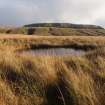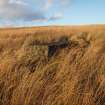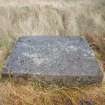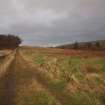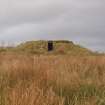Field Visit
Date 6 December 2017
Event ID 1039881
Category Recording
Type Field Visit
Permalink http://canmore.org.uk/event/1039881
A control shelter, 7 fire trench enclosures, 29 concrete platforms and a well-engineered metalled road are all that has been observed of this World War Two Civil Starfish Decoy, which is visible on RAF air photographs (58/A/419: 5199-5200) flown in 1949 and All Scotland Survey Aerial Photographs (ASS/51588 021-2) flown on 10 June 1988. The site is one of 18 decoys that were constructed as part of the military infrastructure designed to protect the industries in the centre of Glasgow and along the banks of the River Clyde from aerial attack.
The control shelter (NS 42040 77540) is situated on a levelled terrace 475m NNE of Maryland farmhouse and 45m E of a metalled road that passes the S corner of Square Wood on the way to service the platforms in the SE sector of the decoy. The shelter is enclosed on the ENE and NNE by a ditch up to 3.6m broad and 0.7m deep. It measures 9m from WNW to ESE by 4m transversely over brick walls 0.38m thick and 2m high, within a grass-grown earthen blast wall up to 4m thick and 2.4m high. The flat, reinforced concrete roof, which has been waterproofed with a layer of bitumen, retains a turf capping, although this has eroded on the ESE. An escape hatch covered by a modern iron grill is located in the middle of its WNW edge. The grass-grown foundations of a brick baffle on the SSW, positioned 1.4m from the blast wall at the mid-point of the structure, shielded a canopied entrance above a raised concrete threshold leading into a corridor. Opposed entrances at its NNE end provide access to two square compartments that are flooded. The walls of the control room on the WNW have been cement rendered and whitewashed. It exhibits few fittings. However, 6 steel rungs attached to the WNW wall permit egress from the escape hatch, while missing fixtures are marked by voids or areas of discolouration in the walls’ render. A low plinth in the S corner marks the location of a stove and above this is a square aperture in the roof for a chimney. There are also rectangular vents connected to circular pipes just above floor level in the NNE and SSW walls, which emerge on the far side of the turf blast wall. The walls of the generator room on the opposite side of the corridor have also been cement rendered and whitewashed. It contains plinths for three engines, the one closest to the door being distinguished by a pair of small square cut-outs in its long sides. A wooden baton runs up the ESE wall and then horizontally along the ceiling above a large circular aperture high in the ESE wall. The latter, measuring 0.23m in diameter, emitted the exhausts from the generators, while three pipes just above floor level conducted gasses to the external expansion chambers of which there is little trace. Rectangular vents just above floor level close to the NNW and SSW corners of the room are connected to pipes, 0.4m in diameter, that emerge from the far side of the turf blast wall.
The grass-grown concrete foundation of an L-shaped building is situated about 7m WNW of the shelter. It is flush with the ground and measures 8m from WNW to ESE by 4.75m transversely over walls that were no more than 0.1m thick. The metalled road to the W continues on a NE course for another 350m before turning initially NW for about 90m and again sharply NE once more. In this length, where it measures about 4m wide and is accompanied by a ditch on the N, it runs for another 90m, immediately NW of a cluster of 16 rectangular concrete blocks situated in broken ground near the foot of a south facing slope (centred NS 42130 77975). These platforms, which are both rectangular and square on plan, occur in three distinct shapes and sizes. The four smallest, measuring about 1.5m square and up to 0.3m thick, sometimes retain T-shaped angle irons on their upper surface close by their corners. These are probably the supports of metal tanks, but evidence for these and other kinds of iron fitting are much rarer on the larger platforms, which are grouped loosely into six pairs – one platform of the pair measuring about 3.5m by 2m and 0.5m thick, while the other measures about 6.5m by 1m and 0.3m thick. A smaller cluster of platforms is situated on the crest of the slope about 80m NE (centred NS 42195 78085). This comprises one small square platform and two pairs of the larger types. In addition, there are two further groups situated further NW. One comprising two pairs (centred NS 42020 78075) is situated about 20m SE of a bomb crater (see below), while the other comprising one pair, a long thin platform and a small square platform, is situated on the slope above the Auchenreoch Glen (centred NS 42055 78185).
The earthworks shown faintly on the aerial photographs survive, but they are for the most part very difficult to discern at ground level. The best preserved is a curvilinear enclosure situated on the summit of the hill (NS 42029 78167), which measures 28.5m from WNW to ESE by 18.5m transversely, within a grass-grown, scraped-up earth bank 2.4m thick and up to 0.7m high. Its SW arc appears to be overlain by the most north-westerly of four rectangular enclosures (NS 42010 78157, NS 42023 78142, NS 42042 78119 and NS 42055 78105) measuring about 23m from NE to SW by 8m transversely, within earth banks up to 2m thick and 0.2m high. They appear to have been laid out in pairs, each being sub-divided into three compartments. A similar pair is situated about 280m ENE (NS 42280 78226 and NS 42308 78202).
Three bomb craters (NS41939 78171, NS 42002 78096 and NS 41840 77988) are situated within the decoy. They measure 8m-15.5m in diameter and up to 1.4m deep. All are surrounded by a low ring of upcast measuring up to 1.75m thick and 0.3m high. The two larger craters on the S-facing slope immediately below the summit of the hill contain standing water, but the smallest situated about 190m SW is simply a dry grass-grown hollow.
Visited by HES, Survey and Recording (ATW, GFG) 6 December 2017.










